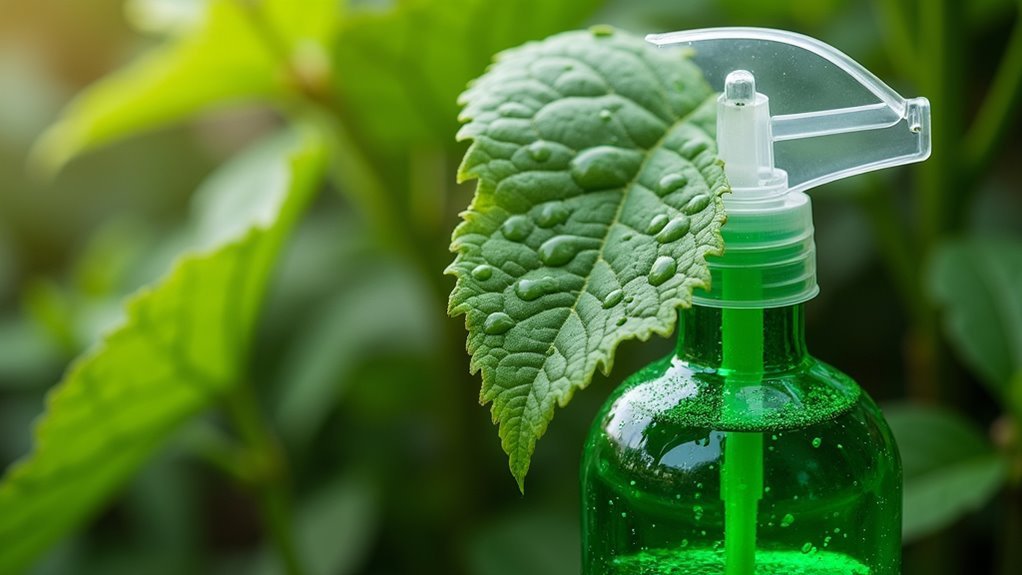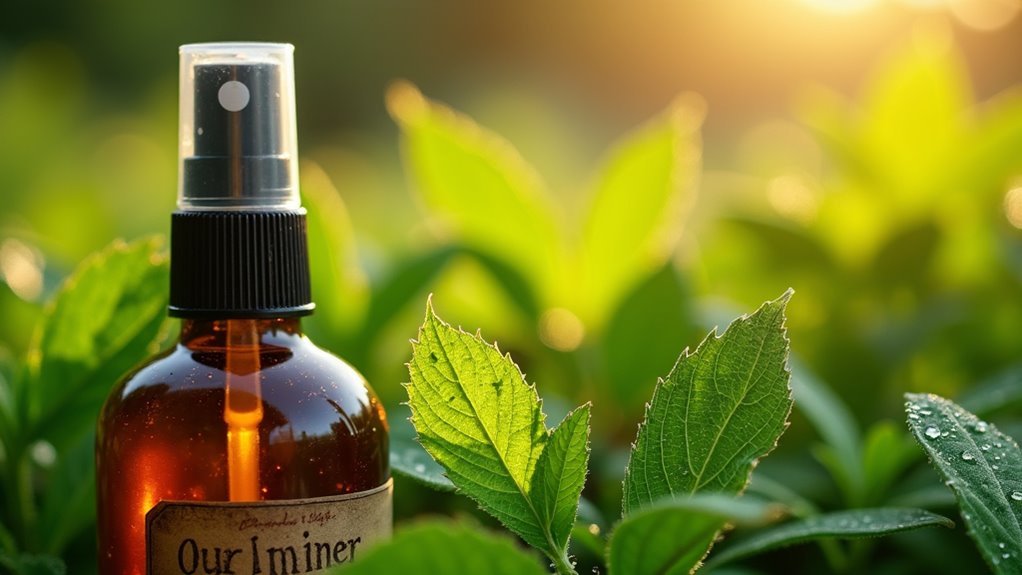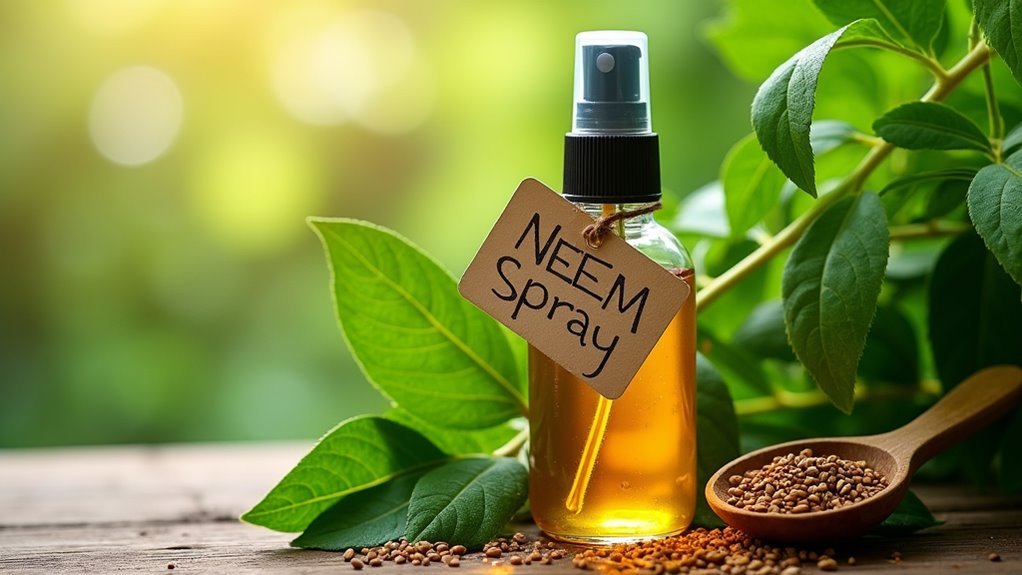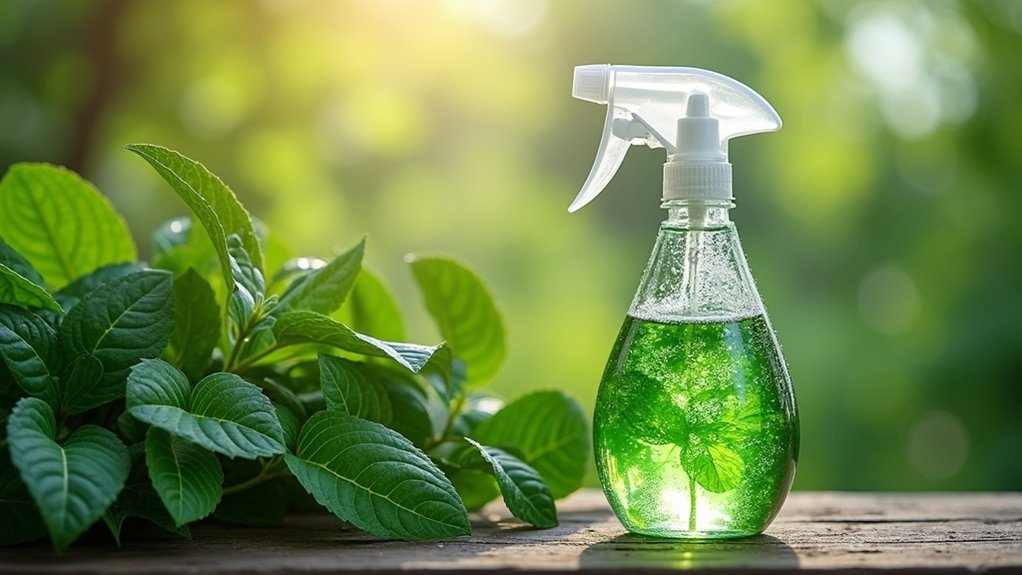You can create an effective homemade leaf miner spray by mixing 2 tablespoons of neem oil with 1 teaspoon of mild liquid soap and 1 quart of water. Apply this solution every 7-14 days during early morning or late evening, ensuring complete coverage of both leaf surfaces. The neem oil disrupts the larvae’s feeding and reproduction cycle, gradually reducing populations over time. For severe infestations, you’ll need more frequent applications and integrated strategies to maximize your success.
What Are Leaf Miners and How Do They Damage Plants

Hidden beneath the surface of your plant’s leaves, tiny larvae are carving destructive tunnels that can spell disaster for your garden. Leaf miners are insects whose larvae burrow through leaf tissue, creating distinctive squiggly lines or blotches filled with waste material called frass.
This damage isn’t just cosmetic—it directly interferes with your plant’s ability to photosynthesize and produce energy.
You’ll encounter different species like spinach, vegetable, and citrus leaf miners, each targeting specific plants. The larvae’s feeding activity reduces your crops’ marketability and can cause severe plant stress.
Heavily infested leaves often drop off, leading to stunted growth or plant death. With multiple generations per season, these pests reproduce rapidly, making early intervention essential for protecting your garden.
Signs Your Plants Have a Leaf Miner Infestation
How can you tell if leaf miners have invaded your garden? You’ll notice distinctive squiggly trails or winding lines across your leaves – these are the feeding tunnels larvae create as they consume leaf tissue from within.
| Sign | Location | Description |
|---|---|---|
| Squiggly trails | Leaf surface | Winding feeding patterns |
| Blisters/blotches | Upper leaf surface | Raised areas filled with frass |
| Yellowing patches | Throughout leaf | Discolored, damaged tissue |
| Premature leaf drop | Entire plant | Severe infestation result |
| Larvae/eggs | Leaf undersides | Tiny, hard-to-see pests |
Look for blisters or blotches on upper leaf surfaces containing frass (insect waste). Affected leaves develop yellowing or browning patches, eventually dropping prematurely during severe infestations. Check leaf undersides for tiny larvae or eggs, though they’re difficult to spot since leaf miners live between leaf layers. Monitor vulnerable plants like vegetables and citrus trees regularly for early detection.
Why Neem Oil Works Against Leaf Miners

While many pest control options exist, neem oil stands out as one of the most effective natural solutions for combating leaf miners. This powerful oil contains azadirachtin, a natural compound that disrupts larvae growth and development, preventing them from reaching adulthood.
When you apply neem oil to affected plants, it works double duty as both a repellent and pesticide, deterring adults from laying eggs while eliminating existing larvae.
Neem oil’s systemic properties make it particularly effective since your plants absorb it, creating ongoing internal protection. The oil circulates through plant tissues, making survival nearly impossible for leaf miners.
You’ll see best results when applying early in infestations, as neem oil can suffocate larvae before significant leaf damage occurs. This organic approach protects beneficial insects while eliminating pests.
Essential Ingredients for DIY Neem Leaf Miner Spray
Creating an effective neem oil spray requires just three simple ingredients that you likely already have at home. These essential ingredients work together to create a powerful leaf miner deterrent that’ll protect your plants naturally.
Three common household ingredients combine to form a natural, powerful defense against destructive leaf miners threatening your garden plants.
Here’s what you’ll need for your DIY solution:
- 2 tablespoons of neem oil – The active ingredient that disrupts leaf miner feeding and reproduction
- 1 teaspoon of mild liquid soap – Acts as an emulsifier to help the oil adhere to plant surfaces
- 1 quart of water – Serves as the base for diluting the mixture to safe application levels
The soap is vital because it prevents the oil from separating and guarantees even coverage on your plants. You’ll want to shake this mixture thoroughly before each use to maintain proper distribution of all components.
Step-by-Step Recipe for Homemade Neem Treatment

You’ll need to get the neem oil mixing ratios right to create an effective leaf miner treatment that won’t harm your plants.
The standard recipe calls for 1 teaspoon of pure neem oil mixed with 1 teaspoon of mild liquid soap in a quart of water, but timing your application correctly is just as important as the mixture itself.
Let’s walk through the complete recipe and learn when to apply this homemade spray for maximum effectiveness against leaf miners.
Neem Oil Mixing Ratios
The perfect neem oil spray starts with getting your ratios right. Proper neem oil mixing ratios guarantee maximum effectiveness against leaf miners while protecting your plants from damage.
You’ll need to follow precise measurements to create a solution that’s both potent and safe.
Here’s the essential ratio breakdown:
- Base mixture: Combine 2 tablespoons of neem oil with 1 teaspoon of mild liquid soap
- Water dilution: Mix this base into 1 quart (4 cups) of water
- Final concentration: This creates approximately a 1.5% neem oil solution
Always shake your mixture thoroughly before each application. The soap acts as an emulsifier, helping the oil distribute evenly throughout the water.
Without proper emulsification, the oil won’t coat leaves effectively, reducing your spray’s ability to disrupt leaf miners’ feeding and reproduction cycles.
Application Timing Methods
While neem oil concentration matters, timing your applications correctly determines whether your homemade treatment succeeds or fails against leaf miners.
Apply your neem oil spray during early morning or late evening hours when temperatures are cooler. This timing prevents leaf burn and maximizes absorption into plant tissues.
Your application timing methods should focus on disrupting the leaf miner’s life cycle. Reapply every 7 to 14 days consistently, and always after rainfall washes away previous treatments.
Before implementing your full spray schedule, test the solution on a small plant section to check for adverse reactions.
Proper Application Techniques for Maximum Effectiveness
Creating an effective homemade leaf miner spray is only half the battle—proper application techniques determine whether your treatment succeeds or fails. Your approach must be strategic to reach larvae hiding between leaf layers.
Follow these essential application steps:
- Use proper equipment – Select a fine spray nozzle that creates a penetrating mist, allowing the water mixture to reach deep into leaf crevices where larvae hide.
- Ensure complete coverage – Spray both upper and lower leaf surfaces thoroughly, as miners often reside in areas you can’t easily see.
- Test first – Always apply your homemade solution to a small, inconspicuous plant section before treating the entire affected area.
Reapply every 5-7 days, especially after rain washes away your treatment.
When and How Often to Apply Neem Spray
You’ll achieve the best results with neem spray by applying it during early morning or late evening hours when beneficial insects are less active.
Apply the treatment every 7 to 14 days throughout spring and summer when leaf miners are most problematic.
Consider weather conditions carefully, as rain can wash away the spray and extreme heat can reduce its effectiveness.
Best Application Timing
Since neem oil can cause leaf burn when exposed to intense sunlight, you’ll achieve the best results by applying your homemade spray during the cooler parts of the day—either early morning or late afternoon.
This best application timing protects your plants while maximizing the spray’s effectiveness against leaf miners.
Follow this schedule for ideal results:
- Apply every 7-14 days during the growing season to disrupt the leaf miner life cycle
- Reapply after rainfall or heavy watering since moisture dilutes the neem oil’s potency
- Monitor plants regularly for new leaf miner activity and adjust timing accordingly
Consistency matters more than frequency.
Regular applications throughout the growing season will gradually reduce leaf miner populations and prevent new infestations from establishing.
Frequency and Intervals
Typically, you’ll need to apply your homemade neem oil spray every 7 to 14 days to maintain effective leaf miner control. The frequency depends on infestation severity and weather conditions. Monitor your plants consistently and adjust intervals based on pest activity levels.
| Infestation Level | Application Frequency | Your Plants’ Future |
|---|---|---|
| Light | Every 14 days | Thriving and healthy |
| Moderate | Every 10 days | Protected and recovering |
| Severe | Every 7 days | Fighting for survival |
Always reapply after rainfall or heavy watering, as neem oil washes off easily. Apply during early morning or late evening to prevent leaf burn and protect beneficial insects. Test on a small area first to verify your plants won’t react adversely to the treatment.
Weather Condition Considerations
Weather conditions play an essential role in determining when and how often you should apply your neem spray for maximum leaf miner control.
These weather condition considerations directly impact the spray’s effectiveness and your plant’s response to treatment.
Key timing guidelines include:
- Optimal application times: Apply during cooler parts of the day like early morning or late evening to prevent rapid evaporation and enhance leaf absorption.
- Weather monitoring: Avoid windy days that cause drift and heavy rain that prevents proper adhesion to plant surfaces.
- Temperature adjustments: Increase application frequency during hot, dry weather when leaf miner activity intensifies and higher temperatures boost their feeding behavior.
Always test a small plant area first, especially during extreme weather conditions.
Safety Precautions When Using Neem Oil
Proper application of neem oil requires several essential safety measures to protect both you and your plants.
When following safety precautions when using neem oil, always wear protective clothing, gloves, and a mask to prevent skin contact and avoid inhaling the oil mist during application.
You’ll need to dilute neem oil according to manufacturer’s instructions to prevent leaf burn and guarantee effective pest control.
Apply the solution during evening or early morning hours to minimize sunlight exposure, which can degrade the oil’s effectiveness and damage your plants.
Before treating your entire garden, conduct a patch test on a small, inconspicuous plant area to check for adverse reactions.
Store your neem oil in a cool, dark location to maintain its potency and prevent degradation.
Combining Neem Treatment With Other Organic Methods
You’ll maximize neem oil’s effectiveness against leaf miners by combining it with complementary organic treatments rather than relying on a single approach.
Strategic application timing and proper mixing techniques can greatly boost your pest control results when you integrate multiple natural methods.
Let’s explore how to layer these organic strategies for thorough leaf miner management.
Neem Oil Application Methods
While neem oil works effectively on its own against leaf miners, combining it with other organic methods creates a more powerful defense system that targets these pests at multiple stages of their development.
You’ll maximize your neem oil’s impact by integrating these application strategies:
- Enhanced mixture preparation – Mix neem oil with insecticidal soap to improve adherence to leaf surfaces and penetration into tissue where larvae hide.
- Strategic timing – Apply treatments during late afternoon or evening to protect beneficial insects while maximizing absorption by leaf miners.
- Comprehensive management approach – Combine neem oil applications with regular plant inspections, removal of infested leaves, and introduction of beneficial predators like parasitic wasps.
This multi-pronged strategy disrupts leaf miners’ feeding and reproductive processes more effectively than single-method approaches, creating lasting protection for your plants.
Integrated Organic Control Strategies
Since leaf miners adapt quickly to single treatment methods, creating an integrated organic control strategy dramatically increases your success rate against these persistent pests.
You’ll boost neem oil’s effectiveness by combining it with insecticidal soap, which suffocates larvae while neem disrupts their life cycle. Apply this combination every 7-14 days while monitoring for early infestations.
Enhance your integrated organic control strategies by introducing parasitic wasps alongside neem treatments. This creates a natural predator-prey balance, reducing chemical dependency.
Complement neem applications with garlic spray to repel egg-laying adults. Hand-pick affected leaves and dispose of them properly to reduce larvae populations immediately.
This multi-faceted approach addresses different life stages simultaneously, creating a thorough defense system that’s harder for leaf miners to overcome than single-method treatments.
Monitoring Results and Prevention Strategies
After applying your homemade leaf miner spray, establish a weekly inspection routine to monitor your plants for those characteristic squiggly trails and browning patches that signal leaf miner activity.
Consistent monitoring results will help you gauge your spray’s effectiveness and catch new infestations early.
Regular monitoring allows you to assess spray performance and detect emerging leaf miner problems before they become severe infestations.
Document your findings systematically to track treatment success:
- Keep detailed logs of leaf miner sightings, spray applications, and their effectiveness to refine your approach.
- Remove infested leaves immediately and destroy them to prevent larvae from completing their development cycle.
- Rotate crops annually to disrupt leaf miner life cycles and reduce reinfestation risks.
You’ll need to maintain vigilance during peak growing seasons when leaf miners are most active, adjusting your spray frequency based on what your monitoring reveals.
Frequently Asked Questions
What Is the Best Homemade Leaf Miner Spray?
You’ll find the vegetable oil, dish soap, and water mixture most effective since it suffocates larvae on contact. Mix equal parts oil and soap with double the water, then spray directly on infested leaves.
What Home Remedy Kills Leaf Miners?
You can kill leaf miners using white oil spray made from equal parts oil, dish liquid, and water. Apply it to both leaf sides to suffocate the larvae effectively.
What Is the Best Defense Against Leaf Miners?
You’ll get the best defense against leaf miners by implementing Integrated Pest Management. Combine regular monitoring, cultural controls like proper watering, biological predators, and targeted treatments to effectively minimize populations.
What Is the Organic Solution for Leaf Miners?
You can use insecticidal soap by mixing one tablespoon liquid soap with one quart water, or apply neem oil spray to disrupt their life cycle and make leaves taste bitter.
In Summary
You’ve now got a proven strategy to tackle leaf miners naturally. Remember, consistency’s key – stick to your spray schedule and monitor your plants regularly. Don’t rely solely on neem oil; combine it with proper garden hygiene and beneficial insects for maximum effectiveness. With patience and persistence, you’ll see healthier foliage and fewer mining trails. Your homemade neem spray isn’t just cost-effective; it’s a sustainable solution that protects both your plants and the environment.





Leave a Reply